story by Kayte Deioma
photos courtesy of Blaine Kern’s Mardi Gras World
UPDATE: Mardi Gras World relocated across the river. The new address is
1380 Port of New Orleans Place, New Orleans, LA 70130 USA.
June 2006 – The Algiers section of New Orleans, on what is known as the “west bank” of the Mississippi (although it is actually south at this point), was unaffected by the floodwaters that deluged everything for miles on the other side of the river
The miles of devastation in New Orleans and surrounding parishes all lie east of the Mississippi River, between the high ground near the river and Lakes Pontchartrain and Borgne. Everything on the west bank was spared, including the community of Algiers, home of Blaine Kern’s Mardi Gras World, where it’s Mardi Gras all year long.
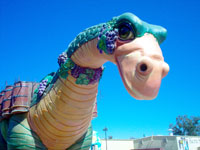 Everything at Mardi Gras World is larger than life. You feel a bit like Alice in Wonderland after eating the cake that makes you smaller and smaller. To enhance the fantasy, you may adorn yourself in Mardi Gras finery to explore the giant floats created over the years by Blaine Kern and a staff of talented artists. Since the 1950’s Blaine Kern has been redefining the Mardi Gras experience with bigger and grander floats designed to last more that one Mardi Gras season. In addition to Mardi Gras, Blaine Kern Studios provide floats, statues and props for theme parks, parades, movie sets and events around the world.
Everything at Mardi Gras World is larger than life. You feel a bit like Alice in Wonderland after eating the cake that makes you smaller and smaller. To enhance the fantasy, you may adorn yourself in Mardi Gras finery to explore the giant floats created over the years by Blaine Kern and a staff of talented artists. Since the 1950’s Blaine Kern has been redefining the Mardi Gras experience with bigger and grander floats designed to last more that one Mardi Gras season. In addition to Mardi Gras, Blaine Kern Studios provide floats, statues and props for theme parks, parades, movie sets and events around the world.
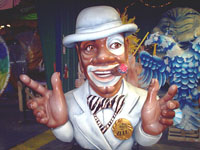 The tour is introduced by a guide and includes a brief film about the history of Mardi Gras and of Blaine Kern studios. You can choose your Mardi Gras regalia – will it be pink feathers and a glittery crown or an armored cloak? Then explore on your own the warehouses full of fiberglass floats including the massive animatronic dragon, Leviathan, that was the largest float in Carnival history when it was created in 1998, or the even larger 5-tandem superfloat, the SS Captain Eddie which took over the record for longest float in the 1999 season.
The tour is introduced by a guide and includes a brief film about the history of Mardi Gras and of Blaine Kern studios. You can choose your Mardi Gras regalia – will it be pink feathers and a glittery crown or an armored cloak? Then explore on your own the warehouses full of fiberglass floats including the massive animatronic dragon, Leviathan, that was the largest float in Carnival history when it was created in 1998, or the even larger 5-tandem superfloat, the SS Captain Eddie which took over the record for longest float in the 1999 season.
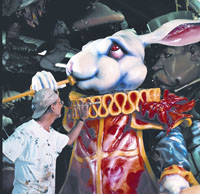 You will also have the opportunity to visit the studios where designers, painters and sculptors are hard at work repairing and creating characters of all sizes for various purposes. Yellow arrows lead you to the float-building warehouses where carpenters and painters are hard at work constructing floats.
You will also have the opportunity to visit the studios where designers, painters and sculptors are hard at work repairing and creating characters of all sizes for various purposes. Yellow arrows lead you to the float-building warehouses where carpenters and painters are hard at work constructing floats.
Each tour ends with coffee and a piece of King Cake. Careful where you bite! By tradition each cake contains a tiny plastic doll, the recipient of which buys the next cake.
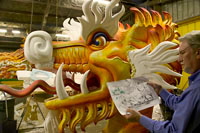 Located directly across from the French Quarter, Algiers can be reached by driving across the New Orleans Bridge or taking the free ferry from Canal Street. On a rainy day, you might want to drive if you have wheels. The bridge takes you close to Mardi Gras World, but you can also take your car on the ferry for $1. The ferry runs from 6 am to 8:45 pm daily, departing every 15 or 20 minutes, depending on how long it takes to load and unload on each side of the river. The crossing itself only takes about 5 minutes. A shuttle from Mardi Gras World picks up visitors every 15 minutes at the Algiers ferry station. On the return trip, the shuttle makes an optional stop at HooDoo Town.
Located directly across from the French Quarter, Algiers can be reached by driving across the New Orleans Bridge or taking the free ferry from Canal Street. On a rainy day, you might want to drive if you have wheels. The bridge takes you close to Mardi Gras World, but you can also take your car on the ferry for $1. The ferry runs from 6 am to 8:45 pm daily, departing every 15 or 20 minutes, depending on how long it takes to load and unload on each side of the river. The crossing itself only takes about 5 minutes. A shuttle from Mardi Gras World picks up visitors every 15 minutes at the Algiers ferry station. On the return trip, the shuttle makes an optional stop at HooDoo Town.
Blaine Kern’s Mardi Gras World
233 Newton St.
New Orleans, LA 70114
Phone: (504) 361-7821
Website: www.mardigrasworld.com
Blaine Kern’s Mardi Gras World is included in the discount New Orleans Pass
Check reviews on TripAdvisor

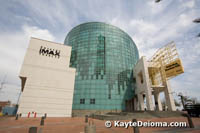 The Audubon Institute’s Aquarium of the Americas in New Orleans has been known as one of the top aquariums in the country since it first opened in 1990. The cylindrical glass building with its sharply angled roof managed to escape major harm from Hurricanes Katrina and Rita and avoided being flooded due to its position on the high banks of the Mississippi. But the power outage that followed the disaster and the failure of the backup generators caused heavy losses to the Aquarium’s sea life. After millions of dollars in repairs and restocking, the Aquarium reopened to the public at the end of May, 2006.
The Audubon Institute’s Aquarium of the Americas in New Orleans has been known as one of the top aquariums in the country since it first opened in 1990. The cylindrical glass building with its sharply angled roof managed to escape major harm from Hurricanes Katrina and Rita and avoided being flooded due to its position on the high banks of the Mississippi. But the power outage that followed the disaster and the failure of the backup generators caused heavy losses to the Aquarium’s sea life. After millions of dollars in repairs and restocking, the Aquarium reopened to the public at the end of May, 2006.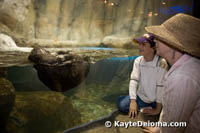 They were able to evacuate a few of the animals to other aquariums, so some familiar faces are back. The colony of African black-footed penguins and Rockhopper penguins survived, as well as the playful sea otters, Emma and Buck, and Mydas the giant green sea turtle.
They were able to evacuate a few of the animals to other aquariums, so some familiar faces are back. The colony of African black-footed penguins and Rockhopper penguins survived, as well as the playful sea otters, Emma and Buck, and Mydas the giant green sea turtle.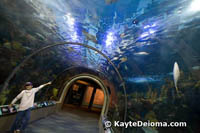 Other new additions were collected by the staff off the Florida Keys for the Caribbean Reef exhibit. TheCaribbean Reef Tunnel puts you under the sea amid intricate coral reefs teaming with life. Schools of fish and kite-shaped stingrays swim over and around you.
Other new additions were collected by the staff off the Florida Keys for the Caribbean Reef exhibit. TheCaribbean Reef Tunnel puts you under the sea amid intricate coral reefs teaming with life. Schools of fish and kite-shaped stingrays swim over and around you. Spots, the famous white alligator, still reigns over theMississippi River Gallery. He may lie so still that he looks stuffed, but the staff assures me that he starts getting active when he’s hungry. If you’re lucky, you might witness feeding time, but it only happens once or twice a week. The Mississippi River exhibit is also home to catfish, turtles, a red-tailed hawk, and an owl.
Spots, the famous white alligator, still reigns over theMississippi River Gallery. He may lie so still that he looks stuffed, but the staff assures me that he starts getting active when he’s hungry. If you’re lucky, you might witness feeding time, but it only happens once or twice a week. The Mississippi River exhibit is also home to catfish, turtles, a red-tailed hawk, and an owl.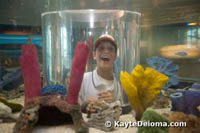 Brand new to the Aquarium in March 2007 is Adventure Island, with a touch pond of cownose rays and a children’s play area where kids can stick their head up in the middle of a fish tank, or climb inside a clam shell with a giant pearl.
Brand new to the Aquarium in March 2007 is Adventure Island, with a touch pond of cownose rays and a children’s play area where kids can stick their head up in the middle of a fish tank, or climb inside a clam shell with a giant pearl.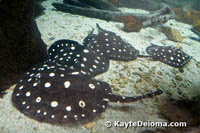
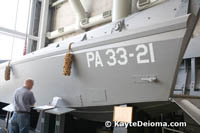 Higgins boats, also known as LCVPs (Landing Craft, Vehicle, Personel), are credited with allowing the allies to win World War II. They’re also the reason that you’ll find theNational World War II Museum in New Orleans. These amphibious vessels were modeled after the Eureka, a flat-bottomed boat designed by New Orleanian Andrew Jackson Higgins to navigate the swamps and bayous of Louisiana by reversing off land banks when they ran aground. The modified version, with a ramp to offload its cargo of one jeep and 12 soldiers, was one of half a dozen military vessels designed and built by Higgins Industries in New Orleans.
Higgins boats, also known as LCVPs (Landing Craft, Vehicle, Personel), are credited with allowing the allies to win World War II. They’re also the reason that you’ll find theNational World War II Museum in New Orleans. These amphibious vessels were modeled after the Eureka, a flat-bottomed boat designed by New Orleanian Andrew Jackson Higgins to navigate the swamps and bayous of Louisiana by reversing off land banks when they ran aground. The modified version, with a ramp to offload its cargo of one jeep and 12 soldiers, was one of half a dozen military vessels designed and built by Higgins Industries in New Orleans.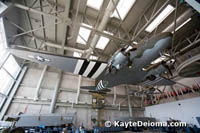 A replica of an LCVP, built according to the original plans, is on display in the Louisiana Memorial Pavilion at the National WWII Museum. The relatively small craft is overshadowed by the Douglas C-47 hanging overhead in the cavernous space. Other military vehicles on display in the Pavilion include a US tank, and jeeps, a German motorcycle and Howitzer, and a Supermarine Spitfire airplane from the British Royal Air Force.
A replica of an LCVP, built according to the original plans, is on display in the Louisiana Memorial Pavilion at the National WWII Museum. The relatively small craft is overshadowed by the Douglas C-47 hanging overhead in the cavernous space. Other military vehicles on display in the Pavilion include a US tank, and jeeps, a German motorcycle and Howitzer, and a Supermarine Spitfire airplane from the British Royal Air Force.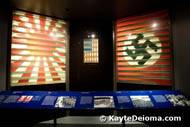 There’s a clear progression through the galleries. You begin with the build up to war and the imbalance of military forces. A graphic display using miniature soldiers against national flags shows how under-armed the American military was compared to the massive build up of forces in Germany and Japan. Even Italy had three times the military might of the U.S before the United States was forced into the war.
There’s a clear progression through the galleries. You begin with the build up to war and the imbalance of military forces. A graphic display using miniature soldiers against national flags shows how under-armed the American military was compared to the massive build up of forces in Germany and Japan. Even Italy had three times the military might of the U.S before the United States was forced into the war.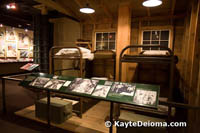 America Goes to War shows how the military buildup in America affected the people at home, from the implementation of the draft to women and minorities landing higher paying jobs in factories. Stacks of tires and piles of artillery shells demonstrate how sacrifices at home supplied the war effort. You can see the 1943 pennies made of steel so that the copper could be used for communication wire on the battle fields.
America Goes to War shows how the military buildup in America affected the people at home, from the implementation of the draft to women and minorities landing higher paying jobs in factories. Stacks of tires and piles of artillery shells demonstrate how sacrifices at home supplied the war effort. You can see the 1943 pennies made of steel so that the copper could be used for communication wire on the battle fields.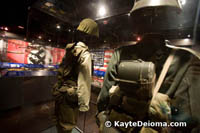 In the War in Europe section you can compare the uniforms of American and German soldiers as well as the weapons with which they were armed. You can also take a look inside a GI’s pockets to see what he would have been carrying, from his toothbrush and extra socks to shaving cream and toilet paper.
In the War in Europe section you can compare the uniforms of American and German soldiers as well as the weapons with which they were armed. You can also take a look inside a GI’s pockets to see what he would have been carrying, from his toothbrush and extra socks to shaving cream and toilet paper.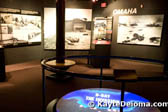 150,000 troops on the shores of Normandy in France on June 6, 1944 in what is now known as D-Day. This military reference to the undisclosed day an operation is to be implemented actually applies to every operation, but in common parlance, it refers to the execution of Operation Overlord. A tableau shows the density of ships and aircraft crossing the English Channel.
150,000 troops on the shores of Normandy in France on June 6, 1944 in what is now known as D-Day. This military reference to the undisclosed day an operation is to be implemented actually applies to every operation, but in common parlance, it refers to the execution of Operation Overlord. A tableau shows the density of ships and aircraft crossing the English Channel.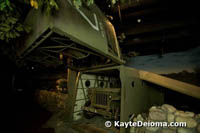 The strategy is laid out in personal stories of the assault by American, British and Canadian troops on five different French beaches. The stories of Omaha Beach, where American soldiers met the greatest German resistance, are accompanied by the compelling photos of the onslaught by the famous war photographer Robert Capa.
The strategy is laid out in personal stories of the assault by American, British and Canadian troops on five different French beaches. The stories of Omaha Beach, where American soldiers met the greatest German resistance, are accompanied by the compelling photos of the onslaught by the famous war photographer Robert Capa.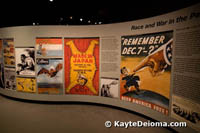 sides of the battle. Photos and stories illustrate the challenging physical conditions faced by soldiers and the heavy losses due to disease. A series of D-Day panels shows a timeline of D-Days for major operations in the Pacific theatre. TheAtom Bomb display is located at the bend in the hallway leading to Victory in the Pacific around the corner.
sides of the battle. Photos and stories illustrate the challenging physical conditions faced by soldiers and the heavy losses due to disease. A series of D-Day panels shows a timeline of D-Days for major operations in the Pacific theatre. TheAtom Bomb display is located at the bend in the hallway leading to Victory in the Pacific around the corner.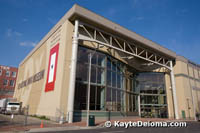 If you read everything and watch the videos, you could spend all day. There are plenty of exhibits that are relatively self-explanatory without reading all the informational panels if you’re pressed for time, or not a big museum reader. If you want to do the reading at home before you go, check out the history section of the museum’s website. It provides much of the information on the extensive exhibit panels. Then you can spend your museum time studying the artifacts and photos.
If you read everything and watch the videos, you could spend all day. There are plenty of exhibits that are relatively self-explanatory without reading all the informational panels if you’re pressed for time, or not a big museum reader. If you want to do the reading at home before you go, check out the history section of the museum’s website. It provides much of the information on the extensive exhibit panels. Then you can spend your museum time studying the artifacts and photos.